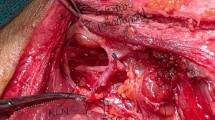Abstract
Background
To reduce intraoperative and postoperative complications, using Lugol solution to preoperatively prepare patients with Graves’ disease has (1) rapidly reduced the severity of thyrotoxicosis and (2) reduced the vascularity of the thyroid gland. The vascularity reduction normally accompanies reducing the severity of thyrotoxicosis. However, the effects and mechanism of Lugol solution for reducing blood flow have not been well investigated in the patients with euthyroid (normally functioning thyroid) Graves’ disease.
Methods
Twenty-five patients with euthyroid Graves’ disease being preoperatively treated with Lugol solution for 10 days were measured, at baseline and on the operative day, for (1) superior thyroid artery blood flow; (2) systemic angiogenic factor (VEGF); and (3) systemic inflammatory factor [interleukin (IL)-16].
Results
All three parameters were significantly (p < 0.0001) lower after 10 days of Lugol solution treatment. The average reductions were blood flow: 60 % (0.294 vs. 0.117 L/min), serum VEGF: 55 % (169.8 vs. 76.7 pg/mL), and serum IL-16: 50 % (427.2 vs. 214.2; pg/mL).
Conclusion
Lugol solution significantly reduced thyroid arterial blood flow, VEGF, and IL-16, even in patients with euthyroid Graves’ disease. We recommend routine preoperative Lugol solution treatment for all patients with Graves’ disease.



Similar content being viewed by others
References
Huang SM, Chow NH, Lee HL et al (2003) The value of color flow Doppler ultrasonography of the superior thyroid artery in the surgical management of Graves disease. Arch Surg 138:146–151 (discussion 151)
Erbil Y, Ozluk Y, Giriş M et al (2007) Effect of lugol solution on thyroid gland blood flow and microvessel density in the patients with Graves’ disease. J Clin Endocrinol Metab 92:2182–2189
Ansaldo GL, Pretolesi F, Varaldo E et al (2000) Doppler evaluation of intrathyroid arterial resistances during preoperative treatment with Lugol’s iodide solution in patients with diffuse toxic goiter. J Am Coll Surg 191:607–612
Plummer HS (1923) Results of administering iodine to patients having exophthalmic goiter. JAMA 80:1955–1966
Ramsden JD (2000) Angiogenesis in the thyroid gland. J Endocrinol 166:475–480
Iitaka M, Miura S, Yamanaka K et al (1998) Increased serum vascular endothelial growth factor levels and intrathyroidal vascular area in patients with Graves’ disease and Hashimoto’s thyroiditis. J Clin Endocrinol Metab 83:3908–3912
Nagasaki T, Inaba M, Kumeda Y et al (2007) Significance of thyroid blood flow as a predictor of methimazole sensitivity in untreated hyperthyroid patients with Graves’ disease. Biomed Pharmacother 61:472–476
Nagura S, Katoh R, Miyagi E et al (2001) Expression of vascular endothelial growth factor (VEGF) and VEGF receptor-1 (Flt-1) in Graves disease possibly correlated with increased vascular density. Hum Pathol 32:10–17
Suzuki K, Kimura H, Wu H et al (2010) Excess iodide decreases transcription of NIS and VEGF genes in rat FRTL-5 thyroid cells. Biochem Biophys Res Commun 393:286–290
Gianoukakis AG, Khadavi N, Smith TJ (2008) Cytokines, Graves’ disease, and thyroid-associated ophthalmopathy. Thyroid 18:953–958
Antonelli A, Rotondi M, Fallahi P et al (2006) Increase of interferon-gamma-inducible CXC chemokine CXCL10 serum levels in patients with active Graves’ disease, and modulation by methimazole therapy. Clin Endocrinol (Oxf) 64:189–195
Aust G, Sittig D, Steinert M et al (2002) Graves’ disease is associated with an altered CXCR3 and CCR5 expression in thyroid-derived compared to peripheral blood lymphocytes. Clin Exp Immunol 127:479–485
Gianoukakis AG, Douglas RS, King CS et al (2006) Immunoglobulin G from patients with Graves’ disease induces interleukin-16 and RANTES expression in cultured human thyrocytes: a putative mechanism for T-cell infiltration of the thyroid in autoimmune disease. Endocrinology 147:1941–1949
Gu XJ, Cui B, Zhao ZF et al (2008) Association of the interleukin (IL)-16 gene polymorphisms with Graves’ disease. Clin Immunol 127:298–302
Pritchard J, Horst N, Cruikshank W et al (2002) Igs from patients with Graves’ disease induce the expression of T cell chemoattractants in their fibroblasts. J Immunol 168:942–950
Pritchard J, Han R, Horst N et al (2003) Immunoglobulin activation of T cell chemoattractant expression in fibroblasts from patients with Graves’ disease is mediated through the insulin-like growth factor I receptor pathway. J Immunol 170:6348–6354
Mysliwiec J, Palyga I, Nikolajuk A et al (2012) Serum interleukin-16 and RANTES during treatment of Graves’ orbitopathy with corticosteroids and teleradiotherapy. Endokrynol Pol 63:92–96
Astwood EB (1984) Landmark article May 8, 1943: Treatment of hyperthyroidism with thiourea and thiouracil. By E.B Astwood. JAMA 251:1743–1746
Chang DC, Wheeler MH, Woodcock JP et al (1987) The effect of preoperative Lugol’s iodine on thyroid blood flow in patients with Graves’ hyperthyroidism. Surgery 102:1055–1061
Pritchard J, Tsui S, Horst N et al (2004) Synovial fibroblasts from patients with rheumatoid arthritis, like fibroblasts from Graves’ disease, express high levels of IL-16 when treated with Igs against insulin-like growth factor-1 receptor. J Immunol 173:3564–3569
Douglas RS, Gianoukakis AG, Kamat S et al (2007) Aberrant expression of the insulin-like growth factor-1 receptor by T cells from patients with Graves’ disease may carry functional consequences for disease pathogenesis. J Immunol 178:3281–3287
Mor F, Quintana FJ, Cohen IR (2004) Angiogenesis-inflammation cross-talk: vascular endothelial growth factor is secreted by activated T cells and induces Th1 polarization. J Immunol 172:4618–4623
Author information
Authors and Affiliations
Corresponding author
Rights and permissions
About this article
Cite this article
Huang, SM., Liao, WT., Lin, CF. et al. Effectiveness and Mechanism of Preoperative Lugol Solution for Reducing Thyroid Blood Flow in Patients with Euthyroid Graves’ Disease. World J Surg 40, 505–509 (2016). https://doi.org/10.1007/s00268-015-3298-8
Published:
Issue Date:
DOI: https://doi.org/10.1007/s00268-015-3298-8




